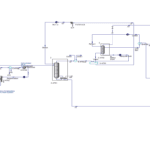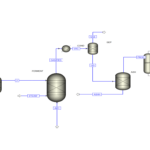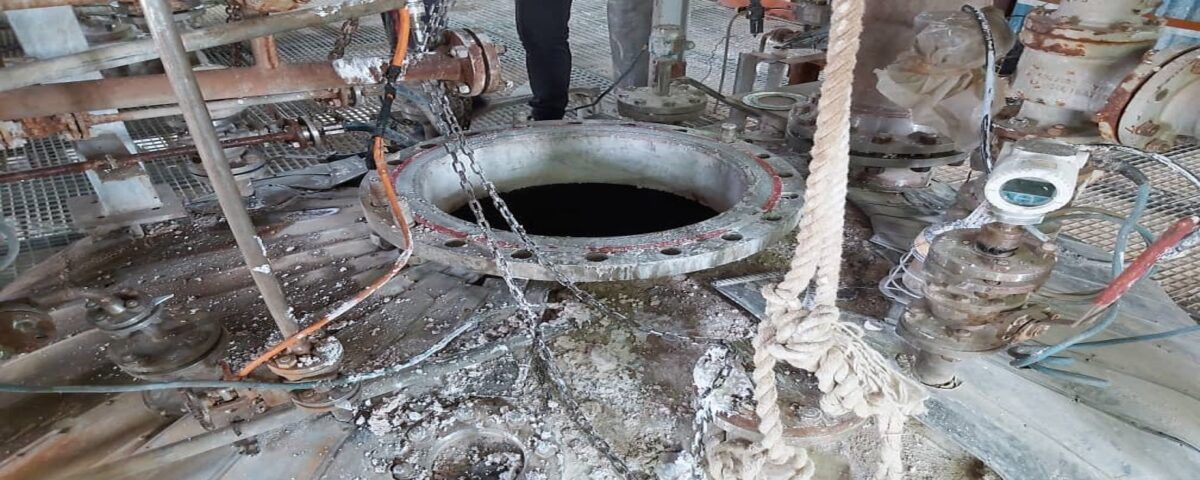Introduction
Industrial processes, especially in the petrochemical and polymer industries, require strict control of operating conditions to achieve quality products that meet safety standards. One of the main challenges in PVC production is the effective removal of vinyl chloride monomer (VCM) from latex. VCM, as one of the toxic and dangerous substances,. must be completely separated from the final product before storage or entering the next stages of the process. In this regard, unit 445 (degassing) is designed to perform this sensitive and necessary operation.
Using advanced technologies such as water ring vacuum pumps and low pressure steam injection, the 445 degassing. unit separates the unreacted monomer from the latex and reduces it to a standard range. This unit is designed to reduce the VCM content in the final product to the range of 250-300 ppm. And this process is done under controlled conditions of temperature and pressure.
The Purpose of The Simulation
The main purpose of simulating this process in Aspen Plus software has been to analyze the process behavior under different operating conditions and to optimize key parameters. By using this advanced tool, process engineers are able to accurately analyze and simulate how the system works. To ensure higher productivity and better control of the process in real conditions.
In this report, along with the general review of the degassing process. the details of the simulation performed in the polymer phase with Aspen Plus software will be comprehensively presented. The presented information can be used as a guide for operation and optimization of unit 445 (degassing) of Arvand Petrochemical.
Description of The Process
Arvand Petrochemical Unit 445 (degassing) is designed with the aim of reducing the concentration of unreacted vinyl chloride monomer (VCM) in PVC latex. After the completion of the polymerization process, latex containing VCM continuously enters this unit. so that dissolved gases, including VCM, are separated from it. The degassing process in this unit is done continuously and several key techniques are used to increase the efficiency of monomer removal. These techniques include the use of low pressure steam, water ring vacuum pumps and multi-stage degassing vessels.
First Step: Entering The Latex Into The Degassing Vessel
The latex containing VCM, after polymerization, enters the degassing vessels (45V-44501A-C) from the polymer reactors. In this step, the latex is sprayed into the vessels using steam spray nozzles (45V-44501A-C-CI01). Low pressure steam is used to heat the latex and accelerate the separation of monomers from the latex. With this method, latex droplets release unreacted monomer and other gases in the vicinity of hot steam.
Second Stage: Separation of Steam and Monomers
When steam enters the degassing vessel, it is injected into the latex droplets through the spray nozzles, causing it to heat up. This heating leads to the evaporation of a part of the steam and the release of VCM from the latex. The pressure in the degassing vessel is adjusted to 0.3 bar by a controller. To provide optimal conditions for gas separation. The steam used passes through a filter to avoid any possible contamination.
The Third Step: Disposal of Separated Monomers and Vapors
Released gases, including VCM and steam, continuously exit from the top of the degassing vessel. These gases are cooled through heat exchangers (45E-44501A-B) and enter the droplet separator system. to separate any liquid, latex or PVC particles from gases. This separation is done by lamellae inside the system. After that, the remaining VCM is transferred to the monomer recycling unit through water ring pumps.
Fourth Step: Transfer of Degassed Latex
The degassed latex, now containing very small amounts of VCM (about 250-300 ppm), is transferred to storage tanks (unit 455). Then this product is directed to the next stages of processing or storage. At this stage, materials separated from latex including water and VCM are also collected and transferred to recycling units.
Control The Process and Prevent The Formation of Foam
One of the main challenges in the degassing unit is to prevent the formation of foam in the degassing vessels. The presence of foam can disrupt the operation of the unit and reduce productivity. For this purpose, a de-foamer system has been installed that prevents the formation of foam using anti-foam solutions. The defoamer is automatically activated by the foam detector and injected into the first stage of the degassing vessel.
Vacuum Section and Water Ring Pumps
Blue ring vacuum pumps (45C-44550A-B) are used to create the proper vacuum conditions for effective VCM isolation. These pumps suck the released gases from the top of the degassing vessels and direct them to the VCM recycling unit. The vacuum created by these pumps maintains the pressure inside the vessels at about 290 mbar, which is necessary for effective separation of VCM from latex.
Sewage Transfer
Produced wastewater, including water and remaining VCM, is transferred to the wastewater treatment unit. These effluents pass through the condensers and enter the recycling and purification systems to prevent the discharge of pollutants into the environment.
Description of Simulation in Aspen Plus Software
In the simulation process of polymer containing systems, choosing the right thermodynamic model is of particular importance. In this project, due to the complexities in the polymer systems and the interaction between the polymer and the remaining monomers, a proprietary approach was used. By fine-tuning the experimental data in Aspen Plus software, an attempt was made to model the actual process conditions more accurately. This approach allowed us to achieve simulation results close to reality.
Equipment and Process Modeling
One of the key parts of this simulation is the detailed modeling of the degassing equipment and the associated process. To achieve this goal, degassing vessels and other related equipment such as steam spray nozzles and vacuum pumps were carefully defined in the Aspen Plus environment.
By considering the physical and chemical properties of PVC latex, as well as operating conditions such as high temperature and vacuum pressure, we were able to create a detailed model of the degassing process. In this modeling, the continuous flow of latex into the degassing vessels is balanced by the input and output flow rates.
Also, steam injection rates were adjusted to achieve maximum VCM separation with minimum energy consumption. Due to the high viscosity and stickiness of the polymer phase, this simulation was associated with certain challenges that were solved by carefully adjusting the input parameters and boundary conditions.
Analyzing The Results and Optimizing The Process
After running the simulation, the results were analyzed to evaluate the efficiency of the process and identify opportunities for optimization. One of the most important outputs of this simulation was the separation rate of VCM from PVC latex. According to different operating conditions, the effect of temperature and pressure on process performance was investigated.
The results showed that by optimally setting the operating pressure to about 290 mbar and the operating temperature to about 70 °C, the maximum separation of VCM can be achieved. The analyzes showed that the optimization of these conditions can lead to a reduction in energy consumption and an increase in process efficiency. Also, these results provide valuable information to improve the design and operation of degassing systems in the future.
Conclusion
The simulation of the 445 degassing unit using Aspen Plus software provided detailed results about the performance and optimization of this unit. Modeling different parts of the process including degassing vessels, vacuum system, and steam spray nozzles allowed us to do this. So that we can effectively analyze the separation efficiency of VCM monomer from latex.
The optimal operation conditions were determined to reduce the concentration of VCM to less than 250-300 ppm. Also, the performance of control systems such as vacuum pumps and steam nozzles was evaluated to ensure the correctness and accuracy of their performance.
From the simulation results, it was found that optimization of pressure, temperature, and steam flow rate can lead to an increase in process efficiency and a decrease in energy consumption. Also, the anti-foam system effectively prevented the formation of foam and ensured the stability of the unit’s operation. Finally, this simulation was recognized as a powerful tool to optimize industrial operations and reduce costs. And suggestions were made to further improve the process.
Simulation and Optimization of Arvand Petrochemical Degassing
In this project, the simulation and optimization of unit 445 (degassing) of Arvand Petrochemical with the aim of effectively removing vinyl chloride monomer (VCM) from latex, has been done using Aspen Plus software and analyzed the operational parameters.


